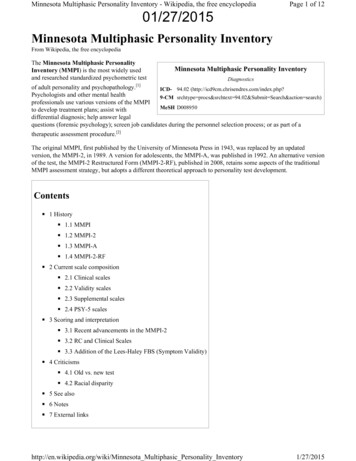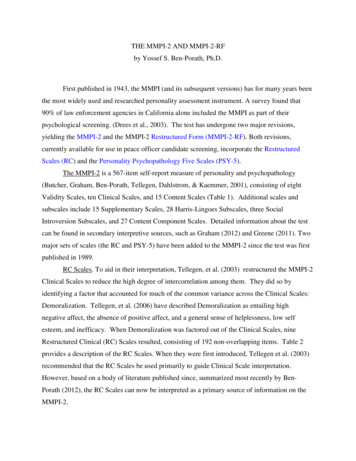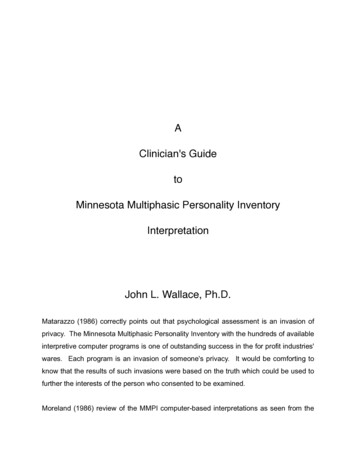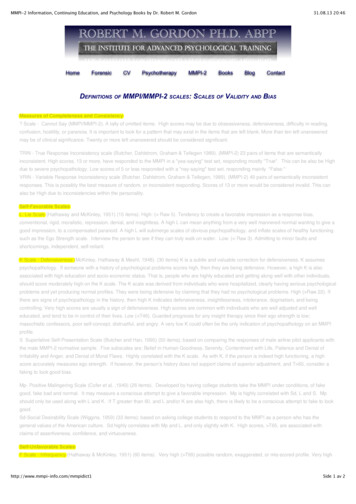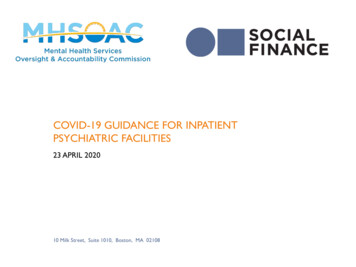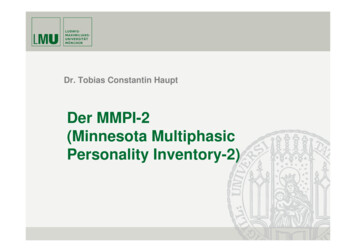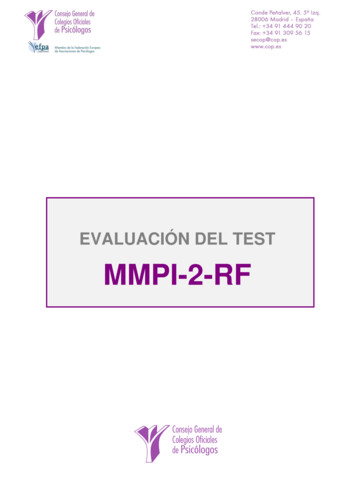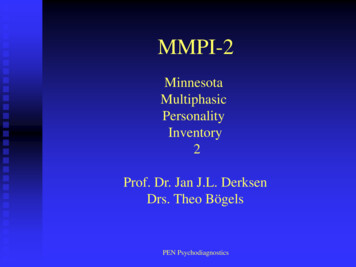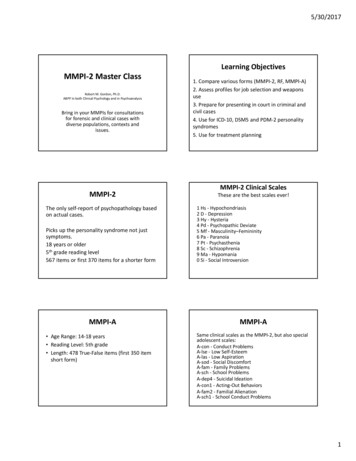
Transcription
SAMPLE REPORTCase Description: Mr. I — Psychiatric InpatientInterpretive ReportMr. I is a 46-year-old, married man admitted for inpatient treatment after presenting with psychoticthinking and assaultive behavior. At intake, he described a recent pattern of decreased sleep and presentedwith bizarre delusional thinking, religious preoccupation, visual hallucinations, and tangential andcircumstantial thinking. He had previously been diagnosed with Schizophrenia and SchizoaffectiveDisorder.Case descriptions do not accompany MMPI-2-RF reports, but are provided here as background information. Thefollowing report was generated from Q-global , Pearson’s web-based scoring and reporting application, using Mr. I.’sresponses to the MMPI-2-RF. Additional MMPI-2-RF sample reports, product offerings, training opportunities, andresources can be found at PearsonClinical.com/mmpi2rf.Copyright 2014 Pearson Education, Inc. or its affiliate(s). All rights reserved. Q-global, Always Learning, Pearson, design for Psi, and PsychCorp are atrademarks, in the U.S. and/or other countries, of Pearson Education, Inc. or its affiliate(s).Minnesota Multiphasic Personality Inventory-2 Restructured Form and MMPI-2-RF are registered trademarks of the University of Minnesota, Minneapolis, MN. 8795-A 01/14
Interpretive Report: Clinical SettingsMMr. I36MaleMarriedNot reported1/13/14SAID Number:Age:Gender:Marital Status:Years of Education:Date Assessed:PLEMMPI-2-RF Minnesota Multiphasic Personality Inventory-2-Restructured Form Yossef S. Ben-Porath, PhD, & Auke Tellegen, PhDCopyright 2008, 2011, 2012 by the Regents of the University of Minnesota. All rights reserved.Distributed exclusively under license from the University of Minnesota by NCS Pearson, Inc. Portions reproduced from the MMPI-2-RF testbooklet. Copyright 2008 by the Regents of the University of Minnesota. All rights reserved. Portions excerpted from the MMPI-2-RF Manualfor Administration, Scoring, and Interpretation. Copyright 2008, 2011 by the Regents of the University of Minnesota. All rights reserved.Used by permission of the University of Minnesota Press.MMPI-2-RF, the MMPI-2-RF logo, and Minnesota Multiphasic Personality Inventory-2-Restructured Form are registered trademarks ofthe University of Minnesota. Pearson, the PSI logo, and PsychCorp are trademarks in the U.S. and/or other countries of Pearson Education,Inc., or its affiliate(s).TRADE SECRET INFORMATIONNot for release under HIPAA or other data disclosure laws that exempt trade secrets from disclosure.[ 2.2 / 1 / QG ]
MMPI-2-RF Interpretive Report: Clinical Settings1/13/14, Page 2ID: Mr. IMMPI-2-RF Validity -4020T Score:Response %:TRIN-rF-r34894Cannot Say (Raw):1257 -30Raw 0086Percent True (of items answered):52 %Comparison Group Data: Psychiatric Inpatient, Community Hospital (Men), N 659):5352 T76606362635345):101028151914181212Percent scoring at orbelow test taker:45765825730.9224559Mean Score (Standard Dev ( 1 SDThe highest and lowest T scores possible on each scale are indicated by a "---"; MMPI-2-RF T scores are non-gendered.VRIN-rTRIN-rF-rFp-rVariable Response InconsistencyTrue Response InconsistencyInfrequent ResponsesInfrequent Psychopathology ResponsesInfrequent Somatic ResponsesFsFBS-r Symptom ValidityResponse Bias ScaleRBSL-r Uncommon VirtuesK-r Adjustment Validity
MMPI-2-RF Interpretive Report: Clinical Settings1/13/14, Page 3ID: Mr. IMMPI-2-RF Higher-Order (H-O) and Restructured Clinical (RC) ScalesHigher-OrderRestructured Clinical120110---100---6050T Score:Response %:---MTHD---BXDRCdRC1SAEID-----20Raw 94969496Comparison Group Data: Psychiatric Inpatient, Community Hospital (Men), N 659Mean Score 512Percent scoring at orbelow test taker:14667522193444875557699Standard Dev ( 1 SDThe highest and lowest T scores possible on each scale are indicated by a "---"; MMPI-2-RF T scores are non-gendered.EID Emotional/Internalizing DysfunctionTHD Thought DysfunctionBXD Behavioral/Externalizing DysfunctionRCdRC1RC2RC3RC4DemoralizationSomatic ComplaintsLow Positive EmotionsCynicismAntisocial BehaviorRC6RC7RC8RC9Ideas of PersecutionDysfunctional Negative EmotionsAberrant ExperiencesHypomanic Activation
MMPI-2-RF Interpretive Report: Clinical Settings1/13/14, Page 4ID: Mr. IMMPI-2-RF Somatic/Cognitive and Internalizing -------------------807060---3020Raw Score:T Score:Response son Group Data: Psychiatric Inpatient, Community Hospital (Men), N 659Mean Score (Standard Dev ( 1 SD): 6258546060745860575861535347): 155Percent scoring at orbelow test taker:34The highest and lowest T scores possible on each scale are indicated by a "---"; MMPI-2-RF T scores are l ComplaintsHead Pain ComplaintsNeurological ComplaintsCognitive ComplaintsSUIHLPSFDNFCSTWSuicidal/Death acyStress/WorryAXYANPBRFMSFAnxietyAnger PronenessBehavior-Restricting FearsMultiple Specific Fears
MMPI-2-RF Interpretive Report: Clinical Settings1/13/14, Page 5ID: Mr. IMMPI-2-RF Externalizing, Interpersonal, and Interest 00---90------80--------------706050------3020T Score:Response 5567674934100100100100100100SARaw 7410010010086100Comparison Group Data: Psychiatric Inpatient, Community Hospital (Men), N 659Mean Score (Standard Dev ( 1 SD): 6161555157515553564754): 14151313141113111511105086914071239721699.2Percent scoring at orbelow test taker:30The highest and lowest T scores possible on each scale are indicated by a "---"; MMPI-2-RF T scores are non-gendered.JCPSUBAGGACTJuvenile Conduct ProblemsSubstance AbuseAggressionActivationFMLIPPSAVSHYDSFFamily ProblemsInterpersonal PassivitySocial Literary InterestsMechanical-Physical Interests
MMPI-2-RF Interpretive Report: Clinical Settings1/13/14, Page 6ID: Mr. IMMPI-2-RF PSY-5 Scales120110---10090------------7060504030---20Raw Score:T Score:Response 8015511607463634932100969590100Comparison Group Data: Psychiatric Inpatient, Community Hospital (Men), N 659Mean Score ():5058605858):1017111415Percent scoring at orbelow test taker:99.17164332Standard Dev ( 1 SDThe highest and lowest T scores possible on each scale are indicated by a "---"; MMPI-2-RF T scores are evisedNegative Emotionality/Neuroticism-RevisedIntroversion/Low Positive Emotionality-Revised
MMPI-2-RF Interpretive Report: Clinical Settings1/13/14, Page 7ID: Mr. IMMPI-2-RF T SCORES (BY DOMAIN)PROTOCOL VALIDITYContent Fp-rUnder-Reporting4745*L-r57 TTRIN-r4266Fs32*FBS-r46RBSK-rSUBSTANTIVE SCALESSomatic/Cognitive 70RC6SATHD46GICINTR-rMRC7Thought Dysfunction52MLSPLEEmotional Dysfunction42RC166RC863PSYC-rBehavioral Dysfunction68BXD62RC480Interpersonal C*The test taker provided scorable responses to less than 90% of the items scored on this scale. See the relevant profile page for the specific percentage.Note. This information is provided to facilitate interpretation following the recommended structure for MMPI-2-RF interpretation in Chapter 5 of theMMPI-2-RF Manual for Administration, Scoring, and Interpretation, which provides details in the text and an outline in Table 5-1.
MMPI-2-RF Interpretive Report: Clinical Settings1/13/14, Page 8ID: Mr. IThis interpretive report is intended for use by a professional qualified to interpret the MMPI-2-RF.The information it contains should be considered in the context of the test taker's background, thecircumstances of the assessment, and other available information.SYNOPSISPROTOCOL VALIDITYContent Non-ResponsivenessPLEScores on the MMPI-2-RF validity scales raise concerns about the possible impact of unscorableresponses on the validity of this protocol. With that caution noted, scores on the substantive scalesindicate cognitive complaints and emotional, thought, behavioral, and interpersonal dysfunction.Cognitive complaints include difficulties in memory and concentration. Emotional-internalizing findingsrelate to suicidal ideation. Dysfunctional thinking includes ideas of persecution and aberrantperceptions and thoughts. Behavioral-externalizing problems include aggression and excessiveactivation. Interpersonal difficulties relate to over-assertiveness.SAMUnscorable ResponsesThe test taker answered less than 90% of the items on the following scales. The resulting scores maytherefore be artificially lowered. In particular, the absence of elevation on these scales is notinterpretable1. A list of all items for which the test taker provided unscorable responses appears underthe heading "Item-Level Information."Symptom Validity (FBS-r): 87%Adjustment Validity (K-r): 86%Cynicism (RC3): 47%Aesthetic-Literary Interests (AES): 86%Inconsistent RespondingThe test taker responded to the items in a consistent manner, indicating that he responded relevantly.Over-ReportingThere are no indications of over-reporting in this protocol.Under-ReportingThere are no indications of under-reporting in this protocol.
MMPI-2-RF Interpretive Report: Clinical Settings1/13/14, Page 9ID: Mr. ISUBSTANTIVE SCALE INTERPRETATIONClinical symptoms, personality characteristics, and behavioral tendencies of the test taker aredescribed in this section and organized according to an empirically guided framework. Statementscontaining the word "reports" are based on the item content of MMPI-2-RF scales, whereas statementsthat include the word "likely" are based on empirical correlates of scale scores. Specific sources foreach statement can be viewed with the annotation features of this report.The following interpretation needs to be considered in light of cautions noted about the possibleimpact of unscorable responses on the validity of this protocol.PLESomatic/Cognitive DysfunctionThe test taker reports a diffuse pattern of cognitive difficulties2. He is likely to complain about memoryproblems3, to have low tolerance for frustration4, not to cope well with stress4, and to experiencedifficulties in concentration5.Emotional DysfunctionThe test taker reports a history of suicidal ideation and/or attempts6. He is likely to be preoccupied withsuicide and death7 and to be at risk for current suicidal ideation and attempts7. This risk is exacerbated bypoor impulse control8.SAMThought DysfunctionThe test taker reports significant persecutory ideation such as believing that others seek to harm him9.He is likely to be suspicious of and alienated from others10, to experience interpersonal difficulties as aresult of suspiciousness11, and to lack insight11.He reports unusual thought processes12. He is likely to experience thought disorganization13, to engagein unrealistic thinking14, and to believe he has unusual sensory-perceptual abilities15.Behavioral DysfunctionThe test taker's responses indicate significant externalizing, acting-out behavior, which is likely to havegotten him into difficulties16. More specifically, he is very likely to be restless and become bored17 and tobe acutely over-activated as manifested in aggression18, mood instability19, euphoria17, excitability20, andsensation-seeking, risk-taking, or other forms of under-controlled, irresponsible behavior21. He reportsepisodes of heightened excitation and energy level22 and may have a history of symptoms associatedwith manic or hypomanic episodes23. He also reports engaging in physically aggressive, violent behaviorand losing control24, and is indeed likely to have a history of violent behavior toward others25.Interpersonal Functioning ScalesThe test taker describes himself as having strong opinions, as standing up for himself, as assertive anddirect, and able to lead others26. He is likely to believe he has leadership capabilities, but to be viewed byothers as domineering, self-centered, and possibly grandiose27. He also reports enjoying social situationsand events28, and is likely to be perceived as outgoing and gregarious29.
MMPI-2-RF Interpretive Report: Clinical Settings1/13/14, Page 10ID: Mr. IInterest ScalesThe test taker reports an above average number of interests in activities or occupations of a mechanicalor physical nature (e.g., fixing and building things, the outdoors, sports)30. Individuals who respond inthis manner are likely to be adventure- and sensation-seeking31. The extent to which he lacks aesthetic orliterary interests cannot be accurately gauged because of unscorable responses. There is possibleevidence that he indicates little or no interest in activities or occupations of an aesthetic or literary nature(e.g., writing, music, the theater)32.DIAGNOSTIC CONSIDERATIONSEmotional-Internalizing Disorders- Cycling mood disorder33Thought DisordersPLEThis section provides recommendations for psychodiagnostic assessment based on the test taker'sMMPI-2-RF results. It is recommended that he be evaluated for the following:M- Disorders involving persecutory ideation34- Disorders manifesting psychotic symptoms35- Personality disorders manifesting unusual thoughts and perceptions36- Schizoaffective disorder37Behavioral-Externalizing DisordersSA- Manic or hypomanic episode or other conditions associated with excessive energy and activation38- Disorders associated with interpersonally aggressive behavior such as intermittent explosive disorder39TREATMENT CONSIDERATIONSThis section provides inferential treatment-related recommendations based on the test taker'sMMPI-2-RF scores.Areas for Further Evaluation- Risk for suicide should be assessed immediately40.- May require inpatient treatment due to hypomania 41.- Need for mood-stabilizing medication42.- Origin of cognitive complaints43. May require a neuropsychological evaluation.
MMPI-2-RF Interpretive Report: Clinical Settings1/13/14, Page 11ID: Mr. IPsychotherapy Process Issues- Persecutory ideation may interfere with forming a therapeutic relationship and treatment compliance44.- Impaired thinking may disrupt treatment36.- Unlikely to be internally motivated for treatment45.- At significant risk for treatment non-compliance45.- Excessive behavioral activation may interfere with treatment42.Possible Targets for TreatmentITEM-LEVEL INFORMATIONUnscorable ResponsesPLE- Mood stabilization in initial stages of treatment41- Persecutory ideation44- Inadequate self-control45- Reduction in interpersonally aggressive behavior39Item Content Omitted. (RC7, NEGE-r)ITEMSNOTItem Content Omitted. (Fs, FBS-r, RC1)SHOWNItem Content Omitted. (FBS-r, K-r, RC3)Item Content Omitted. (VRIN-r, FBS-r, RC3)Item Content Omitted. (VRIN-r, FBS-r, K-r, RC3)Item Content Omitted. (BXD, RC9, DISC-r)Item Content Omitted. (RC3)Item Content Omitted. (RC3)Item Content Omitted. (Fp-r)Item Content Omitted. (VRIN-r, RC6)Item Content Omitted. (F-r, THD, RC8, PSYC-r)Item Content Omitted. (NEGE-r)Item Content Omitted. (RC3)Item Content Omitted. (AES)Item Content Omitted. (RC3)Item Content Omitted. (RC1, NUC)Item Content Omitted. 38.296.304.313.326.MFollowing is a list of items to which the test taker did not provide scorable responses. Unanswered ordouble answered (both True and False) items are unscorable. The scales on which the items appear arein parentheses following the item content.Special Note:The content of the test itemsis included in the actual reports.To protect the integrity of the test,the item content does not appearin this sample report.
MMPI-2-RF Interpretive Report: Clinical Settings1/13/14, Page 12ID: Mr. ICritical ResponsesSeven MMPI-2-RF scales--Suicidal/Death Ideation (SUI), Helplessness/Hopelessness (HLP), Anxiety(AXY), Ideas of Persecution (RC6), Aberrant Experiences (RC8), Substance Abuse (SUB), andAggression (AGG)--have been designated by the test authors as having critical item content that mayrequire immediate attention and follow-up. Items answered by the individual in the keyed direction(True or False) on a critical scale are listed below if his T score on that scale is 65 or higher. Thepercentage of the MMPI-2-RF normative sample (NS) and of the Psychiatric Inpatient, CommunityHospital (Men) comparison group (CG) that answered each item in the keyed direction are provided inparentheses following the item content.PLESuicidal/Death Ideation (SUI, T Score 79)251. Item Content Omitted. (True; NS 3.0%, CG 20.8%)334. Item Content Omitted. (True; NS13.5%, CG 35.5%)Ideas of Persecution (RC6, T Score 70)14. Item Content Omitted. (True; NS 2.9%, CG 8.5%)34. Item Content Omitted. (True; NS 10.6%, CG 27.3%)71. Item Content Omitted. (True; NS 2.0%, CG 17.3%)110. Item Content Omitted. (True; NS 9.9%, CG 32.5%)SAMAberrant Experiences (RC8, T Score 66)32. Item Content Omitted. (True; NS 21.1%, CG 51.0%)85. Item Content Omitted. (False; NS 17.1%, CG 35.2%)106. Item Content Omitted. (True; NS 8.7%, CG 31.7%)159. Item Content Omitted. (True; NS 6.0%, CG 27.0%)240. Item Content Omitted. (True; NS 8.8%, CG 23.2%)257. Item Content Omitted. (True; NS 12.4%, CG 37.0%)Aggression (AGG, T Score 67)23. Item Content Omitted. (True; NS 39.0%, CG 46.3%)312. Item Content Omitted. (True; NS 5.5%, CG 25.8%)316. Item Content Omitted. (True; NS 45.1%, CG 50.5%)329. Item Content Omitted. (True; NS 12.7%, CG 29.3%)337. Item Content Omitted. (True; NS 50.2%, CG 52.2%)ITEMSNOTSHOWNSpecial Note:The content of the test itemsis included in the actual reports.To protect the integrity of the test,the item content does not appearin this sample report.
MMPI-2-RF Interpretive Report: Clinical Settings1/13/14, Page 13ID: Mr. IUser-Designated Item-Level InformationThe following item-level information is based on the report user's selection of additional scales, and/orof lower cutoffs for the critical scales from the previous section. Items answered by the test taker in thekeyed direction (True or False) on a selected scale are listed below if his T score on that scale is at theuser-designated cutoff score or higher. The percentage of the MMPI-2-RF normative sample (NS) andof the Psychiatric Inpatient, Community Hospital (Men) comparison group (CG) that answered eachitem in the keyed direction are provided in parentheses following the item content.ITEMSNOTSHOWNSpecial Note:The content of the test itemsis included in the actual reports.To protect the integrity of the test,the item content does not appearin this sample report.SAMPLEHypomanic Activation (RC9, T Score 80)13. Item Content Omitted. (True; NS 40.9%, CG 43.4%)39. Item Content Omitted. (True; NS 51.0%, CG 53.3%)47. Item Content Omitted. (True; NS 42.7%, CG 45.7%)61. Item Content Omitted. (False; NS 61.6%, CG 73.4%)72. Item Content Omitted. (True; NS 81.5%, CG 69.3%)97. Item Content Omitted. (True; NS 50.5%, CG 45.2%)118. Item Content Omitted. (True; NS 57.4%, CG 61.3%)131. Item Content Omitted. (True; NS 43.3%, CG 47.0%)143. Item Content Omitted. (True; NS 27.5%, CG 32.3%)155. Item Content Omitted. (True; NS 41.6%, CG 37.9%)166. Item Content Omitted. (True; NS 38.9%, CG 31.7%)181. Item Content Omitted. (True; NS 35.3%, CG 36.7%)193. Item Content Omitted. (True; NS 32.8%, CG 38.2%)207. Item Content Omitted. (True; NS 66.9%, CG 47.3%)219. Item Content Omitted. (True; NS 51.5%, CG 54.9%)244. Item Content Omitted. (True; NS 56.9%, CG 64.5%)248. Item Content Omitted. (True; NS 16.1%, CG 25.6%)256. Item Content Omitted. (True; NS 65.7%, CG 58.1%)267. Item Content Omitted. (True; NS 12.9%, CG 32.0%)292. Item Content Omitted. (True; NS 26.1%, CG 30.3%)305. Item Content Omitted. (True; NS 37.6%, CG 47.2%)316. Item Content Omitted. (True; NS 45.1%, CG 50.5%)327. Item Content Omitted. (True; NS 41.7%, CG 46.4%)337. Item Content Omitted.(True; NS 50.2%, CG 52.2%)Activation (ACT, T Score 67)72. Item Content Omitted. (True; NS 81.5%, CG 69.3%)166. Item Content Omitted. (True; NS 38.9%, CG 31.7%)181. Item Content Omitted. (True; NS 35.3%, CG 36.7%)207. Item Content Omitted. (True; NS 66.9%, CG 47.3%)219. Item Content Omitted. (True; NS 51.5%, CG 54.9%)267. Item Content Omitted. (True; NS 12.9%, CG 32.0%)
MMPI-2-RF Interpretive Report: Clinical Settings1/13/14, Page 14ID: Mr. IENDNOTESThis section lists for each statement in the report the MMPI-2-RF score(s) that triggered it. In addition,each statement is identified as a Test Response, if based on item content, a Correlate, if based onempirical correlates, or an Inference, if based on the report authors' judgment. (This information canalso be accessed on-screen by placing the cursor on a given statement.) For correlate-based statements,research references (Ref. No.) are provided, keyed to the consecutively numbered reference listfollowing the endnotes.Correlate: Response % 90, Ref. 5Test Response: COG 693Correlate: COG 69, Ref. 3, 10, 214Correlate: COG 69, Ref. 215Correlate: COG 69, Ref. 3, 216Test Response: SUI 797Correlate: SUI 79, Ref. 218Inference: BXD 68; RC9 809Test Response: RC6 7010Correlate: RC6 70, Ref. 1, 3, 4, 11, 15, 19, 2111Correlate: RC6 70, Ref. 2112Test Response: RC8 6613Correlate: RC8 66, Ref. 11, 2114Correlate: RC8 66, Ref. 3, 6, 7, 9, 2115Correlate: RC8 66, Ref. 6, 7, 9, 20, 2116Correlate: BXD 68, Ref. 13, 2117Correlate: RC9 80, Ref. 2118Correlate: RC9 80, Ref. 8, 15, 17, 18, 20, 2119Correlate: RC9 80, Ref. 3, 19, 2120Correlate: RC9 80, Ref. 3, 11, 16, 2121Correlate: RC9 80, Ref. 16, 2122Test Response: ACT 6723Correlate: RC9 80, Ref. 19, 21; ACT 67, Ref. 21, 2324Test Response: AGG 6725Correlate: RC9 80, Ref. 8, 15, 17, 18, 20, 21; AGG 67, Ref. 2126Test Response: IPP 3427Correlate: IPP 34, Ref. 2, 12, 21; AGGR-r 74, Ref. 2128Test Response: SAV 3629Correlate: SAV 36, Ref. 2, 21; INTR-r 32, Ref. 2130Test Response: MEC 7431Correlate: MEC 74, Ref. 2132Test Response: AES 3333Correlate: ACT 67, Ref. 2334Correlate: RC6 70, Ref. 14, 2235Correlate: RC8 66, Ref. 2136Inference: RC8 661SAMPLE2
MMPI-2-RF Interpretive Report: Clinical Settings1/13/14, Page 15ID: Mr. IInference: RC6 70; RC9 80Correlate: ACT 67, Ref. 14, 2339Inference: AGG 6740Inference: SUI 7941Inference: RC9 8042Inference: RC9 80; ACT 6743Inference: COG 6944Inference: RC6 7045Inference: BXD 6837SAMPLE38
MMPI-2-RF Interpretive Report: Clinical Settings1/13/14, Page 16ID: Mr. IRESEARCH REFERENCE LIST1. Arbisi, P. A., Sellbom, M., & Ben-Porath, Y. S. (2008). Empirical correlates of the MMPI-2Restructured Clinical (RC) Scales in psychiatric inpatients. Journal of Personality Assessment, 90,122-128. doi: 10.1080/002238907018451462. Ayearst, L. E., Sellbom, M., Trobst, K. K., & Bagby, R. M. (2013). Evaluating the interpersonalcontent of the MMPI-2-RF Interpersonal Scales. Journal of Personality Assessment, 95, 187-196.doi: 10.1080/00223891.2012.7300853. Burchett, D. L., & Ben-Porath, Y. S. (2010). The impact of over-reporting on MMPI-2-RFsubstantive scale score validity. Assessment, 17, 497-516. doi: 10.1177/1073191110378972PLE4. Cox, A, Pant, H., Gilson, A. N., Rodriguez, J. L., Young, K. R., Kwon, S., & Weed, N. C.,(2012). Effects of augmenting response options on MMPI-2 RC Scale psychometrics. Journal ofPersonality Assessment, 94, 613-619. doi: 10.1080/00223891.2012.7004645. Dragon, W. R., Ben-Porath, Y. S., & Handel, R. H. (2012). Examining the impact of unscorableitem responses on the validity and interpretability of MMPI-2/MMPI-2-RF Restructured Clinical(RC) Scale scores. Assessment, 19, 101-113. doi: 10.1177/1073191111415362M6. Forbey, J. D., Arbisi, P. A., & Ben-Porath, Y. S. (2012). The MMPI-2 computer adaptive version(MMPI-2-CA) in a VA medical outpatient facility. Psychological Assessment, 24, 628-639. doi:10.1037/a0026509SA7. Forbey, J. D., & Ben-Porath, Y. S. (2007). A comparison of the MMPI-2 Restructured Clinical(RC) and Clinical Scales in a substance abuse treatment sample. Psychological Services, 4, 46-58.doi: 10.1037/1541-1559.4.1.468. Forbey, J. D., & Ben-Porath, Y. S. (2008). Empirical correlates of the MMPI-2 RestructuredClinical (RC) Scales in a non-clinical setting. Journal of Personality Assessment, 90, 136-141. doi:10.1080/002238907018451619. Forbey, J. D., Ben-Porath, Y. S., & Gartland, D. (2009). Validation of the MMPI-2 ComputerizedAdaptive Version (MMPI-2-CA) in a correctional intake facility. Psychological Services, 6,279-292. doi: 10.1037/a001619510. Gervais, R. O., Ben-Porath, Y. S., & Wygant, D. B. (2009). Empirical correlates andinterpretation of the MMPI-2-RF Cognitive Complaints scale. The Clinical Neuropsychologist, 23,996-1015. doi: 10.1080/1385404090274824911. Handel, R. W., & Archer, R. P. (2008). An investigation of the psychometric properties of theMMPI-2 Restructured Clinical (RC) Scales with mental health inpatients. Journal of PersonalityAssessment, 90, 239-249. doi: 10.1080/0022389070188495412. Kastner, R. M., Sellbom, M., & Lilienfeld, S. O. (2012). A comparison of the psychometricproperties of the Psychopathic Personality Inventory full-length and short-form versions.Psychological Assessment, 24, 261-267. doi: 10.1037/a0025832
MMPI-2-RF Interpretive Report: Clinical Settings1/13/14, Page 17ID: Mr. I13. Lanyon, R. I., & Thomas, M. L. (2013). Assessment of global psychiatric categories: ThePSI/PSI-2 and the MMPI-2-RF. Psychological Assessment, 25, 227-232. doi: 10.1037/a003031314. Sellbom, M., Bagby, R. M., Kushner, S., Quilty, L. C., & Ayearst, L. E. (2011). Diagnosticconstruct validity of the MMPI-2 Restructured Form (MMPI-2-RF) scale scores. Assessment, 19,176-186. doi: 10.1177/107319111142876315. Sellbom, M., & Ben-Porath, Y. S. (2005). Mapping the MMPI-2 Restructured Clinical (RC)Scales onto normal personality traits: Evidence of construct validity. Journal of PersonalityAssessment, 85, 179-187. doi: 10.1207/s15327752jpa8502 1016. Sellbom, M., Ben-Porath, Y. S., & Bagby, R. M. (2008). Personality and psychopathology:Mapping the MMPI-2 Restructured Clinical (RC) Scales onto the five factor model of personality.Journal of Personality Disorders, 22, 291-312. doi: 10.1521/pedi.2008.22.3.291PLE17. Sellbom, M., Ben-Porath, Y. S., Baum, L. J., Erez, E., & Gregory, C. (2008). Predictive validityof the MMPI-2 Restructured Clinical (RC) Scales in a batterers' intervention program. Journal ofPersonality Assessment, 90, 129-135. doi: 10.1080/0022389070184515318. Sellbom, M., Ben-Porath, Y. S., & Graham, J. R. (2006). Correlates of the MMPI-2Restructured Clinical (RC) Scales in a college counseling setting. Journal of PersonalityAssessment, 86, 89-99. doi: 10.1207/s15327752jpa8601 10M19. Sellbom, M., Graham, J. R., & Schenk, P. (2006). Incremental validity of the MMPI-2Restructured Clinical (RC) Scales in a private practice sample. Journal of Personality Assessment,86, 196-205. doi: 10.1207/s15327752jpa8602 09SA20. Simms, L. J., Casillas, A., Clark, L. A., Watson, D., & Doebbeling, B. I. (2005). Psychometricevaluation of the Restructured Clinical Scales of the MMPI-2. Psychological Assessment, 17,345-358. doi: 10.1037/1040-3590.17.3.34521. Tellegen, A., & Ben-Porath, Y. S. (2008/2011). The Minnesota Multiphasic PersonalityInventory-2-Restructured Form (MMPI-2-RF): Technical manual. Minneapolis: University ofMinnesota Press.22. Van der Heijden, P. T., Egger, J. I. M., Rossi, G., Grundel, G., & Derksen, J. J. L. (2012). TheMMPI-2 Restructured Form and the standard MMPI-2 Clinical Scales in relation to DSM-IV.European Journal of Psychological Assessment. doi: 10.1027/1015-5759/a00014023. Watson, C., Quilty, L. C., & Bagby, R. M. (2011). Differentiating bipolar disorder from majordepressive disorder using the MMPI-2-RF: A receiver operating characteristics (ROC) analysis.Journal of Psychopathology and Behavioral Assessment, 33, 368-374. doi:10.1007/s10862-010-9212-7
MMPI-2-RF Interpretive Report: Clinical Settings1/13/14, Page 18ID: Mr. IEnd of ReportSAMPLEThis and previous pages of this report contain trade secrets and are not to be released in response torequests under HIPAA (or any other data disclosure law that exempts trade secret information fromrelease). Further, release in response to litigation discovery demands should be made only in accordancewith your profession's ethical guidelines and under an appropriate protective order.
MMPI-2-RF Externalizing, Interpersonal, and Interest Scales 20 100 90 80 70 60 50 40 30 JCP SUB AGG ACT FML IPP SAV SHY DSF AES MEC Raw Score: T Score: Response %:
